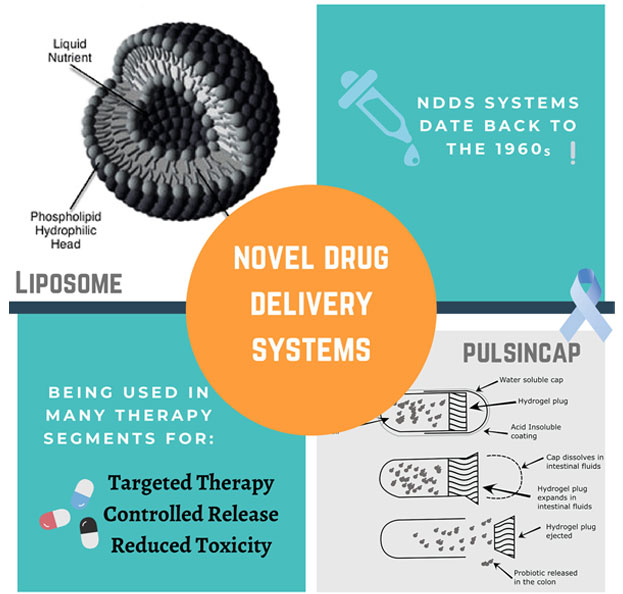Drug delivery mechanism has always been an important aspect in determination of a formulation’s success. Conventional drug delivery systems such as tablets, capsules and parenteral systems, generally lead to distribution of drug throughout the body. These systems also require higher dose administration for maintaining the effective concentration in the therapeutic window. This sometimes, leads to dose dumping and hence, increased risk of adverse effects and toxicity. With the advent of novel drug delivery systems, the approaches for drug delivery have considerably evolved for better. Novel drug delivery systems offer many advantages over conventional drug delivery systems in form of targeted delivery, increased drug solubility, ability to provide delayed or controlled release of drug, decrease in dose dumping of the drug, all of which lead to better treatment outcome.
Emergence of novel drug delivery systems:
It all began in the early 1960s, when hydrophilic gels were considered for biological use in human beings. The scientists worked extensively and identified gels based on glycolmethacrylate as suitable for human use. After extensive testing they were found fit to be used as fillers in the eye following removal of the eye (enucleation). Although the glycolmethacrylate based substance was not per se a drug delivery system, it got scientists thinking on possibilities of the use of synthetic products for human use.1 In 1966, a publication from the Harvard Medical school, discussed how anaesthetic agents such as ether, nitrous oxide, halothane and cyclopropane diffuse through silicone rubber opening the new frontiers of novel drug delivery system2.
As these materials considered for use as drug delivery systems were not biodegradable and needed to be manually removed from the body, concept of degradable drug delivery devices was born. Early 1970s witnessed a turning point in drug delivery systems, when sustained release of cyclazocine was observed when dispensed in biodegradable PLA (polylactic acid) sheets. Subsequently, research in this segment gained momentum and systems based on PLA as long-term drug delivery systems for malaria, cancer, ophthalmology and contraception emerged. The first such system, which focused on erosion of polymeric matrix for drug delivery was developed in 1978 and was made with partial esters of vinyl acetatemaleic anhydride copolymers3. So far, many drug delivery systems based on biodegradable polymers have been successfully commercialized. One such example is Lutrate Depot injectable microspheres of PLA and TEC (Triethyl citrate), containing leuprorelin acetate (LH-RH agonist) for the treatment of prostate cancer.
Applications of novel drug delivery systems:
The evolution of delivery systems over the last decades have helped in the development of advanced treatment options. Therefore, they are used in many therapeutic segments, some of which are discussed here.
a) Ophthalmic drug delivery: Colloidal carriers like nanoparticles, nanosuspensions, dendrimers are some examples of technologies used for ophthalmic delivery. These systems allow sustained drug release, assist in reduction of dosing frequency and increase its bioavailability4.
b) Colon targeted drug delivery: Proprietary technologies such as CODESTM, PulsincapTM system and nanoparticles are a few of the many approaches used for colon targeted drug delivery. The CODESTM system uses the colonic pH and microbial fauna to control the release of the drug. Whereas, PulsincapTM system releases the drug via a swellable hydrogel plug, when it comes in contact with the dissolution fluid. These systems improve solubility and absorption of the drug5.
c) Pulmonary drug delivery: Various delivery options for localised targeting of pulmonary ailments such as, chronic obstructive pulmonary disease and asthma, have emerged. Here, particles such as micelles, dendrimers, nanoparticles etc are used in form of Metered Dose Inhalers and Dry Powder Inhalers for effective drug delivery6.
d) Oncology: Apart from other chronic ailments, novel drug delivery systems have also been found useful in management of one of the most dreaded disease-cancer. Albumin bound Paclitaxel nanoparticles, PEGylated or STEALTH liposomal doxorubicin, microsphere bound leuprolide, are some examples of carrier bound drugs used in oncology7. These systems help with long acting release of drugs and hence, are used for treatment of metastatic breast cancer, AIDs related Kaposi’s sarcoma and tumours of the prostate, ovary, brain, liver and others. They are not only being used as a mainstay therapy for cancer but are also in use for adjuvant and neo-adjuvant purposes for better tumour management.
Due to their versatility and ability to overcome multiple drawbacks of conventional delivery systems, novel drug delivery systems provide better options for therapy to the physicians and also aid in improving the overall patient outcome.
References:
- © 1960 Nature Publishing Group. Published online 1960.
- Folkman J, Long DM, Rosenbaum R. Silicone Rubber: A New Diffusion Property Useful for General Anesthesia. Rubber Chem Technol. 1967;40(3):928-931. doi:10.5254/1.3539107
- Edlund U, Albertsson A. Degradable Polymer Microspheres for Controlled Drug Delivery. 2002;157.
- Tiwari A, Shukla RK. Novel ocular drug delivery systems : An overview. J Chem Pharm Res. 2010;2(3):348-355.
- Mahajan PS. Colon Targeted Microbeads: a Novel Approach in Ndds. World J Pharm Res. 2017;6(11):280-292. doi:10.20959/wjpr201711-9586
- Prasad PV, Pal PC, Rao DN, Shrivastav TG, Ge R-S. Bird’s Eye View on the Recent Advances in Drug Delivery Systems. J Biomater Nanobiotechnol. 2011;02(05):544-556. doi:10.4236/jbnb.2011.225065
- DP_Do_2011.pdf.



Leave A Comment
You must be logged in to post a comment.